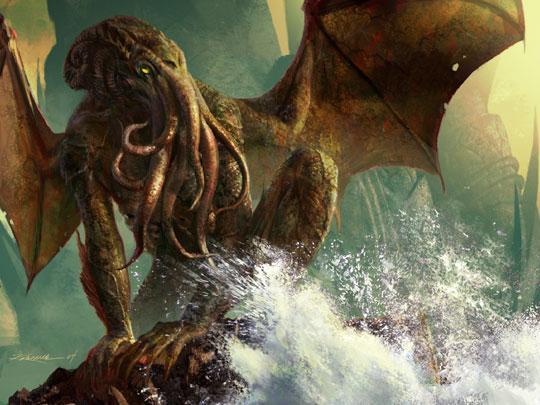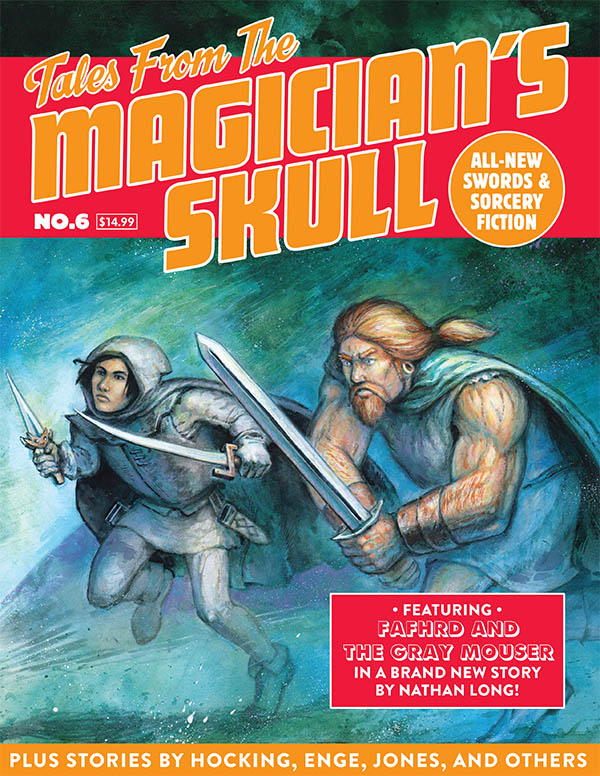
The Cosmic Horror of Sword & Sorcery
by Bill Ward
The bones of sword & sorcery lie close to the skin, and one sure blade-stroke is enough to lay them bare for all to see. There is plot-driven pulp action there, at the core, but supporting that is a foundation of swashbuckling historical adventure, and expectations of encounters of the picaresque and the exotic kind. To be sure we can also see the unsentimentality of the hardboiled, the individualism of the American experience, and a surprising dose of literary realism for a genre concerned with fantastic monsters, haunted crypts, and vampiric blades. It is of course from these supernatural elements that the horror of sword & sorcery emerges – indeed it’s where the ‘sorcery’ part of the name derives, and it is at least as important an ingredient in these tales as self-reliant protagonists, mysterious lost cities, and lands both far and strange.
It is out of the tradition of weird fiction that this strain of horror in sword & sorcery – and cosmic horror in particular – has its origins, and the two primary originators of the sub-genre were both practitioners of such tales. Clark Ashton Smith, whose darkly poetic and evocative stories read like the negative reflection of Dunsanian fantasy, was one of the first to really infuse secondary world tales with a strong dose of the horrific and the macabre. But it was Robert E. Howard who deserves full credit as the creator of sword & sorcery proper, combining all of those elements that would come to be ubiquitous into something greater than the sum of its parts.
Howard was writing for the market. He liked and was good at writing some things more than others, with historical adventure in the vein of Harold Lamb or Talbot Mundy being in both these regards close the top of the list. Constrained by the need for historical research yet under pressure to produce as much as he could, he moved those kinds of stories into secondary worlds of his own imagining, lost prehistoric ages combining all of the things he loved best into an anachronistic stew of colorfully strange yet nonetheless familiar elements. He added the inflection of horror in his creations in much the same way, needing to appeal to the demands of the market, and in particular to Weird Tales magazine.
Its no exaggeration to say Weird Tales was Howard’s primary market, it was not only his first professional sale, but most of Howard’s legendary creations first found their audience in its pages: Kull of Atlantis, Bran Mak Morn, Solomon Kane, and, of course, Conan the Cimmerian, the character that not only became synonymous with sword & sorcery, but has totally eclipsed his creator in terms of renown. And Weird Tales, of course, published weird fiction, its tagline was “the unique magazine,” showcasing strange and supernatural stories in the vein of Edgar Allan Poe, William Hope Hodgson, and M.R. James. The magazine’s most famous contributor, H.P. Lovecraft, was himself a pioneer in the realm of horror, of cosmic horror: awe-inspiring tales of the insane nightmares that lurk in the infinite and unknowable cosmos, in which the insignificance of humanity is at least as disturbing as the gribbly, half-glimpsed fiends of the outer dark that prey upon it.
And it was this strain of cosmic horror that is the most immediate in its inspiration for sword & sorcery, and most fundamental to its nature. Certainly gothic ghosts and murders macabre found themselves transported into an “age undreamed of,” but the standard horror pantheon of the European tradition was less a hallmark of sword & sorcery than the weird tentacled monstrosities and alien malformations of practitioners such as Lovecraft and his extended circle of admirers and imitators. Thus the incomprehensible eldritch horrors from beyond the stars were transformed into the wild creations of dark sorcery, a fitting adversary for the hyper-competent protagonists who dared to challenge the unknown.
But beyond simply furnishing a barbarian with tentacles to sever, cosmic horror influenced the tone and scale of sword & sorcery to a profound degree. Lost cities and civilizations were standard fare in historical adventure, look no further than H. Rider Haggard’s stories of African exploration for multiple famous examples. But cosmic horror was on an entirely different, deep-time scale, and Howard and those inspired by him made full use of it. Not only did Howard give us fabulous lost cities containing ancient secrets, long dead magicians returned to rewrite the world in their image, and creatures so long devolved in dark, forgotten places that it was impossible to guess if they had ever truly been human, but the entire era of the stories themselves is a lost, pre-cataclysmic age, one so far removed from us that it can be little more than a dream.
It’s this contrast between the small, intimate, low-stakes stories of human adventure, daring-do, and survival, and the mind-annihilatingly immense peril of both time and space, that lie at the heart of sword & sorcery and are one of the big secrets of its appeal. The Lovecraftian protagonist may well lose his mind when confronted with such things, and these stories themselves seem to be asking “what can we do against such forces?”
For Howard and those that came after him, the answer was a simple one that paradoxically transformed and elevated the rogue’s gallery of sword & sorcery protagonists – those renegades, savages, thieves, and malcontents – into heroes. So what was their answer to what we can do against the unknowable, the incomprehensible, and the impossible? We can fight!











